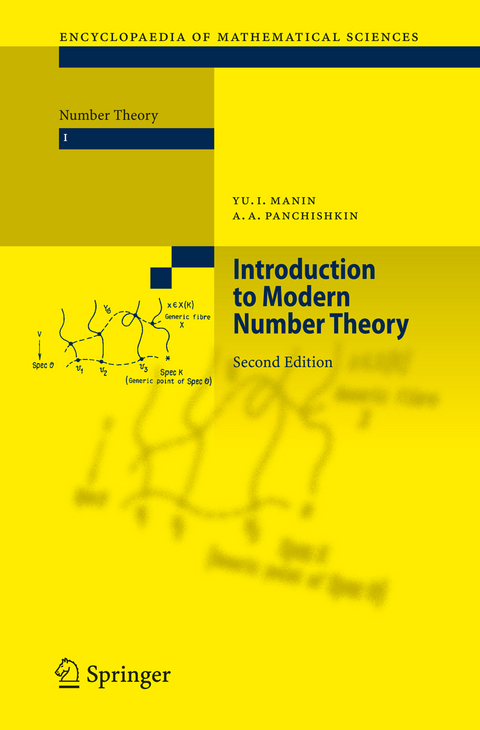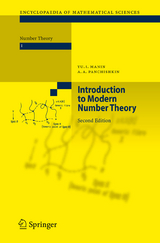Introduction to Modern Number Theory
Springer Berlin (Verlag)
978-3-540-20364-3 (ISBN)
"Introduction to Modern Number Theory" surveys from a unified point of view both the modern state and the trends of continuing development of various branches of number theory. Motivated by elementary problems, the central ideas of modern theories are exposed. Some topics covered include non-Abelian generalizations of class field theory, recursive computability and Diophantine equations, zeta- and L-functions.
This substantially revised and expanded new edition contains several new sections, such as Wiles' proof of Fermat's Last Theorem, and relevant techniques coming from a synthesis of various theories. Moreover, the authors have added a part dedicated to arithmetical cohomology and noncommutative geometry, a report on point counts on varieties with many rational points, the recent polynomial time algorithm for primality testing, and some others subjects.
From the reviews of the 2nd edition:
"... For my part, I come to praise this fine volume. This book is a highly instructive read ... the quality, knowledge, and expertise of the authors shines through. ... The present volume is almost startlingly up-to-date ..." (A. van der Poorten, Gazette, Australian Math. Soc. 34 (1), 2007)
Problems and Tricks.- Number Theory.- Some Applications of Elementary Number Theory.- Ideas and Theories.- Induction and Recursion.- Arithmetic of algebraic numbers.- Arithmetic of algebraic varieties.- Zeta Functions and Modular Forms.- Fermat's Last Theorem and Families of Modular Forms.- Analogies and Visions.- Introductory survey to part III: motivations and description.- Arakelov Geometry and Noncommutative Geometry (d'après C. Consani and M. Marcolli, [CM]).
From the reviews of the second edition:
"Here is a welcome update to Number theory I. Introduction to number theory by the same authors ... . the book now brings the reader up to date with some of the latest results in the field. ... The book is generally well-written and should be of interest to both the general, non-specialist reader of Number Theory as well as established researchers who are seeking an overview of some of the latest developments in the field."
Philip Maynard, The Mathematical Gazette, Vol. 90 (519), 2006
[...] the first edition was a very good book; this edition is even better.
[...] Embedded in the text are a lot of interesting ideas, insights, and clues to how the authors think about the subject. [...]
Things get more interesting in Part II (by far the largest of the tree parts)[...] This part of the book covers such things as approaches through logic, algebraic number theory, arithmetic of algebraic varieties, zeta functions, and modular forms, followed by an extensive (50+ pages ) account of Wiles' proof of Fermat's Last Theorem. This is a valuable addition, new in this edition, and serves as a vivid example of the power of the "ideas and theories" that dominate this part of the book.
Also new and very interesting is Part III, entitled "Analogies and Visions,"
[...] The best surveys of mathematics are those written by deeply insightful mathematicians who are not afraid to infuse their ideas and insights into their outline of subject. This is what we have here, and the result is an essential book. I only wish the price were lower so that I could encourage my students buy themselves a copy. Maybe I'll do that anyway.
Fernado Q. Gouvêa, on 09/10/2005
"This book is a revised and updated version of the first English translation. ... Overall, the book is very well written, and has an impressive reference list. It is an excellent resource for thosewho are looking for both deep and wide understanding of number theory." (Alexander A. Borisov, Mathematical Reviews, Issue 2006 j)
"This edition feels altogether different from the earlier one ... . There is much new and more in this edition than in the 1995 edition: namely, one hundred and fifty extra pages. ... For my part, I come to praise this fine volume. This book is a highly instructive read with the usual reminder that there lots of facts one does not know ... . the quality, knowledge, and expertise of the authors shines through. ... The present volume is almost startlingly up-to-date ... ." (Alf van der Poorten, Gazette of the Australian Mathematical Society, Vol. 34 (1), 2007)
| Erscheint lt. Verlag | 23.5.2005 |
|---|---|
| Reihe/Serie | Encyclopaedia of Mathematical Sciences |
| Zusatzinfo | XVI, 514 p. |
| Verlagsort | Berlin |
| Sprache | englisch |
| Maße | 155 x 235 mm |
| Gewicht | 976 g |
| Themenwelt | Mathematik / Informatik ► Mathematik ► Arithmetik / Zahlentheorie |
| Mathematik / Informatik ► Mathematik ► Wahrscheinlichkeit / Kombinatorik | |
| Naturwissenschaften ► Physik / Astronomie | |
| Schlagworte | Algebraic Varieties • Arakelov geometry • arithmetic • Arithmetic der algebraischen Zahlen • arithmetic of algebraic numbers • commutative property • diophantine equations • Diophantische Gleichungen • Elementare Zahlentheorie • Elementary Number Theory • Elliptic Curves • Elliptische Kurven • langlands program • Langlands-Programm • Logic • Modular Forms • Non-Commutative Geometry • Number Theory • Public • Public Key Cryptosystems • Public key Verschlüsselungssysteme • Zahlentheorie • Zeta-functions |
| ISBN-10 | 3-540-20364-8 / 3540203648 |
| ISBN-13 | 978-3-540-20364-3 / 9783540203643 |
| Zustand | Neuware |
| Haben Sie eine Frage zum Produkt? |
aus dem Bereich




